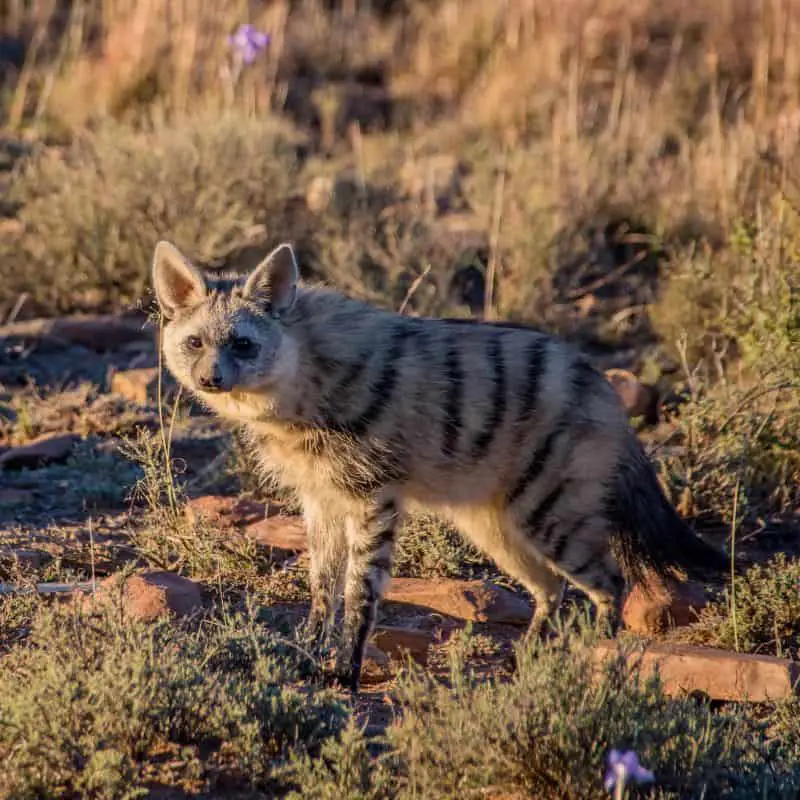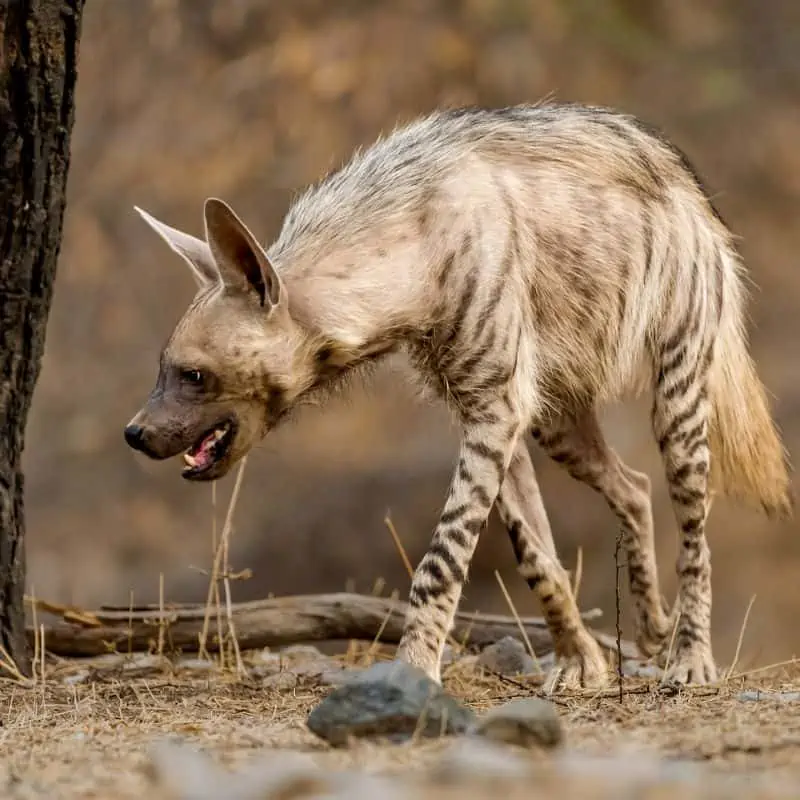Spotted hyenas have one of the most recognizable calls across the African plane. They are one of four species that belong to the family “Hyaenidae.” Most hyenas live in sub-Saharan Africa, across various habitats, and have unique and interesting characteristics. But how long do hyenas live?
The average lifespan for a hyena is roughly ten to twelve years in the wild. In captivity, a hyena lives up to roughly twenty years; however, most die earlier. A hyena’s maximum age depends on several variables, including social hierarchy, injuries, disease, food, and genetics.
Although not particularly long-lived animals, hyenas have an average length lifespan (comparable to many other predators occupying similar niches in their distribution). Below we’ll further investigate hyena lifespans and the various factors influencing them.

An overview of a hyena’s lifespan
While living to an average age of 12 years might seem short to humans (compared to other long-lived species), 12 years is relatively “old” when you look at some of the other maximum ages animals with similar lifestyles to hyenas attain.
For example, male lions live roughly 8 to 10 years, and females up to 16 years. Wild dogs usually live between 5 and 7 years but may reach 12.
According to the Guinness World Records, the oldest hyena lived 28 years and 166 days. His name was Mars, and he was a spotted hyena who lived in the Honolulu Zoo in the US. Mars arrived at the zoo in 1992 with his brother Whoops. Mars passed away in 2017.
While not reaching his brother’s record, Whoops made it to an impressive 26 years old. These two brothers are more of an exception than the trend. Most hyenas in captivity don’t live that much longer than wild animals.
Hyenas belong to the Hyaenidae family, of which there are four members.
- Aardwolf (Proteles cristata) – although the exact lifespan is unknown, experts presume it is around 15 years. One captive female lived to 20 years old.
- Brown hyena (Hyaena brunnea) – between 12 and 13 years. According to Richard Weigl’s 2005 book on captive mammal longevity, the oldest captive Brown hyena lived 31.9 years.
- Spotted hyena (Crocuta crocuta) – these hyenas live to around 15 years old. In captivity, they also usually reach 20 years.
- Striped hyena (Hyaena hyaena) – 10 to 12 years in the wild and up to 20 years in captivity.
Although some evidence suggests that a captive hyena could live to almost 40 years old, this should be seen as a special case and not the norm.

Factors that influence a hyena’s lifespan
Although wild hyenas might reach 12 years (some even make it to 15 years), many of them don’t. In the wild, many limiting factors reduce a hyena’s life expectancy.
Hyenas in captivity live significantly longer than their wild counterparts because they are kept away from the “harms of the world.”
Factors that influence a hyena’s life span/expectancy include:
Lifestyle and social status
We’ve already established that captive hyenas live longer than wild ones because their needs are met. Hyenas generally live longer in areas where they have access to sufficient resources. They receive better nutrition, fight less amongst each other (intraspecific competition), and live a less stressful life.
A hyena’s social standing also influences its lifespan. Hyenas live in “clans,” headed by a dominant animal (or pair). The higher up the ranks a female is, the longer she lives.
Researchers recently discovered that female spotted hyenas are more dominant than males due to their social support in a clan.
I.e., their popularity in the clan means they have a greater backing in an altercation.
Solitary animals also often live shorter lives than those in a clan. Living in a clan increases their chance of obtaining food; however, it also means that those lower on the “pecking” order might not get as much to eat if they were alone.
Habitat and predators
The physical environment that a hyena lives in plays a significant role in limiting or promoting its life expectancy. Shelter from the elements, places to hide, terrain, and the number of similar animals and predators contribute to stress levels and how likely the hyena is to die earlier.
The type of large predators present and their population size influence hyena populations and life expectancy.
E.g., Hyenas in areas with more lions usually have lower life expectancies than those living in areas without lions.
Brown hyenas have a limited habitat range increasing pressure on the animals, while striped hyenas have immense ranges, providing them with “enough space.”

Gender
Female hyenas generally live longer than males (depending on the species).
As they have less support in social groups, male hyenas tend to be on the fringes of groups more frequently (specifically spotted hyenas).
The Brown, striped hyenas, and aardwolves are male-dominated.
To be dominant usually means you need to win/fight for it. Dominate animals rarely reach old age as they become injured in fights.
Genetics, disease, and injury
A hyena’s genetics dictate many crucial variables. With good genetics, an older animal is better supported and healthy, while poor genetics result in an earlier death.
Poor genetics, a lackluster diet, and stress increase the disease risk. Competition between animals of the same and other species for resources often results in injuries. These factors usually reduce a hyena’s life expectancy.
The idea behind natural selection relates to an animal’s genetics. Those with superior genetics can survive whatever “life” throws at them (disease, predation, competition, etc.), and, through this hardship, they still produce fertile offspring who continue to survive and reproduce.
So why don’t all animals live for 100 years? Although natural selection favors the strongest genes moving forward, factors like predation and competition remove even the top contenders.
The advantage of a captive life
Captive animals (those who adjust to captive life) have significant advantages over their wild brethren. Often animals born in the wild and brought into captivity (for rehabilitation, research, breeding programs, or education) might not live as long as an individual born into captivity.
Wild-turned-captive animals may struggle to adjust to the stress of being close to humans.
However, those captive animals that live longer do so because their needs are met and protected/removed from population-regulating factors.
Disease, predation, and death from injuries are critical in managing healthy populations, ensuring that the strongest genes continue. If hyenas overpopulate an area, they could start to have detrimental effects on other animals present.
Common causes of death in hyenas
Hyenas have a strong immune system and don’t frequently die from diseases. However, in 1993 and 1994, a severe pandemic of canine distemper virus killed many young hyenas in Serengeti National Park.
Injuries are the most significant cause of hyena deaths. Many hyenas die from injuries either from other hyenas or from lions.
Humans are another significant limiting factor in hyena longevity. Many farmers prefer not to have hyenas around their properties. They’ll often set traps or put out poison to remove the threats.
Poaching is another cause for concern. Illegal hunting removes otherwise healthy individuals from the population.
Final thoughts on how long hyenas live
The four types of hyenas have an average lifespan of between 10 and 12 years in the wild, while captive animals live to around 20 years.
Although some hyenas may live longer, this is rare.
Several factors influence a hyena’s life expectancy, including its environment, social standing, and genetics.
Most hyenas die due to internal fighting and predation.

